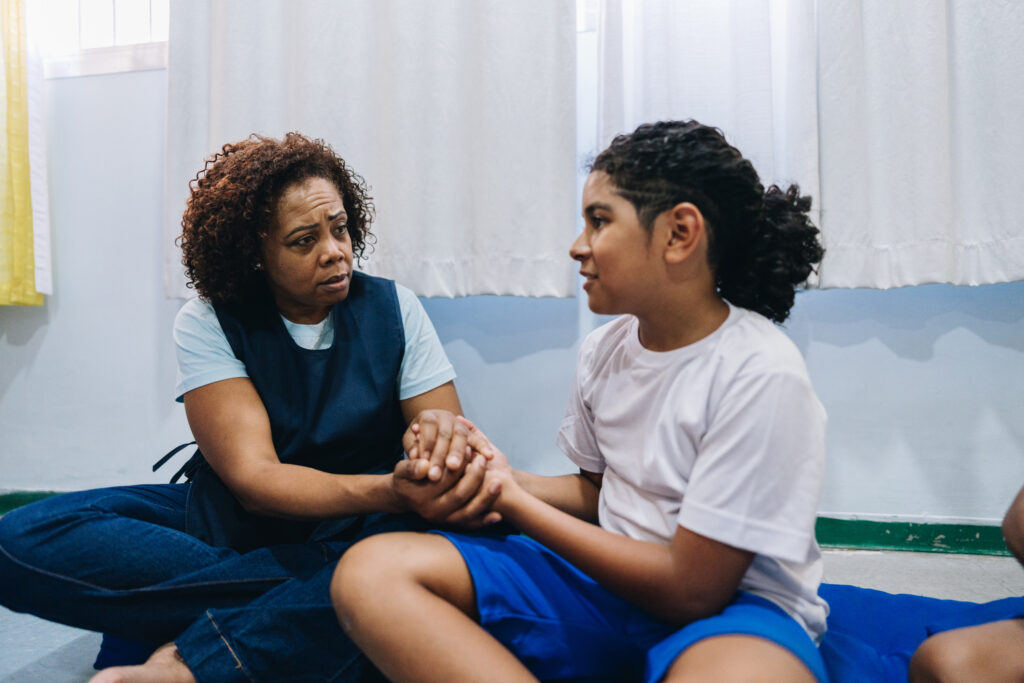Introduction: The Heart of Understanding Behaviour
Every foster carer faces the daily challenges and joys that come with caring for children who have experienced trauma. Behaviours that may seem puzzling or challenging are often attempts by the child to communicate their needs or emotions. This post is designed to help you decode these behaviours through a trauma-informed lens, enabling you to support and connect with the child in your care more effectively.
We’ll explore key concepts like trauma responses, attachment theory, and co-regulation. You’ll learn about practical strategies you can start using today, why these approaches are vital to your child’s development, and how to create supportive environments that promote healing. This journey enhances your understanding and strengthens the bond with the child under your care. So, grab a cup of tea and let’s dive into the world of trauma-informed fostering.
Foundation: Unravelling Trauma Responses
What is a Trauma Response?
A trauma response is an emotional or physical reaction that occurs when a child relives past experiences of trauma. This can include fight, flight, freeze, or fawn behaviours. Understanding these responses helps us see them not as intentional misbehaviour but as survival strategies developed from past adversities.
The Link Between Trauma and Behaviour
When children experience trauma, it changes the way their brain processes information. They might react with aggression (fight), run away (flight), withdraw and shut down (freeze), or people-please (fawn) as ways to manage overwhelming stress. By understanding these patterns, we can interpret the behaviour for what it truly is: a signal for help and understanding.
Challenges for Foster Children
Foster children may have moved multiple times, faced neglect, or witnessed challenging situations. This instability can make it difficult for them to trust caregivers, often resulting in unpredictable behaviours. Your role involves creating a stable, nurturing environment where they can begin to feel safe and understood.
The Role of Foster Carers
As a foster carer, your approach can significantly influence a child’s healing journey. Viewing their behaviour through a trauma-informed lens allows you to respond with empathy and support. By focusing on building a connection, you help the child feel secure enough to begin the healing process.
Importance: Why Understanding Trauma Matters
Effects of Misunderstanding Trauma Responses
Misinterpreting or punishing behaviours can lead to increased emotional distress for the child and can weaken your relationship. Recognising trauma responses early ensures you can provide support and prevent escalation.
The Role of Trust and Safety in Child Development
Children thrive in environments where they feel safe and understood. Trauma-informed approaches acknowledge the child’s past experiences, fostering an atmosphere of trust. This sets the stage for emotional and developmental growth, leading to healthier relationships and improved behaviour over time.
Long-term Benefits of Addressing Trauma
When we address trauma appropriately, we pave the way for long-term mental health improvements and stronger family bonds. Focusing on the child’s needs today contributes to their future ability to form positive relationships, succeed in education, and develop resilience.
Practical Strategies: Approaches for Your Home
Strategy 1: Creating a Safe Environment
Start by making small changes in your home to reduce stress for the child. This might include consistent routines, clear communication, and accessible quiet spaces for them to retreat to if they feel overwhelmed.
Strategy 2: Practising Empathy and Active Listening
When the child shares their feelings, listen actively without judgment. Reflect on what they say and show understanding, which makes them feel valued and heard.
Strategy 3: Building Routine and Predictability
Establish a daily routine that the child can rely on. Predictability helps reduce anxiety and creates a sense of stability, an essential factor in recovering from trauma.
Strategy 4: Encouraging Expression through Play
Use play as a tool for expression. Activities such as drawing, role-play, and storytelling can help children process their experiences and emotions in a non-threatening way.
Adapting Strategies for Different Children
Recognise that every child is unique and may respond differently to strategies. Be patient and ready to adapt your approaches to find what works best for your child’s unique personality and experiences.
Advanced Applications: Navigating Complex Situations
Understanding Complex Trauma
Children with complex trauma may experience multiple, prolonged traumatic events, making their behavioural responses more intricate. Recognising this complexity is crucial when deciding how to support your child best.
Applying Therapeutic Techniques
Introduce therapeutic tools such as mindfulness or breathing exercises to help manage emotional regulation. These can be beneficial in helping children develop coping mechanisms that they can use independently over time.
Working with Professionals
Collaborate with social workers, therapists, and other professionals involved in your child’s life. They can offer guidance, resources, and support that make a significant difference in your caregiving journey.
Seeking Professional Help When Needed
Sometimes challenges may be too complex to handle alone. Don’t hesitate to seek external professional support to ensure your child receives all the care they need.
Conclusion: Embracing Your Role in Healing
Fostering, understanding and addressing trauma goes beyond managing behaviours; it’s about building a foundation of trust, empathy, and connection. Remember, each small step you take towards understanding trauma can significantly impact not just the child’s life, but your household’s well-being. You’re playing a crucial role in this child’s life, and your dedication is helping to build their path towards a brighter, healthier future. Keep nurturing, listening, and supporting – your efforts make all the difference.
|
ReplyForward
|


